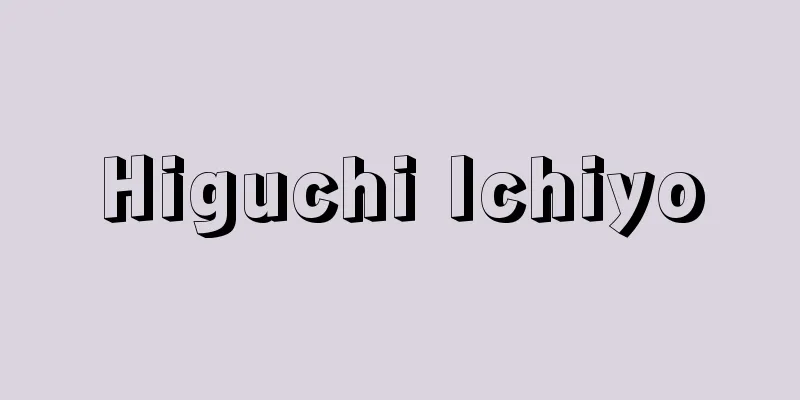Higuchi Ichiyo

|
Novelist and poet. Born on March 25, 1872 (May 2, Gregorian calendar) in the government housing on the grounds of the Tokyo Prefectural Government Office in Uchisaiwai-cho, Tokyo. Her real name was Natsu, and she was also written as Natsuko. Her father, Noriyoshi, and mother, Taki, were both farmers from Kai Province (Yamanashi Prefecture), but at the end of the Edo period, they went to Edo and became police officers of the samurai class. However, at the time of the Meiji Restoration, Noriyoshi became an official at the Tokyo Prefectural Government Office. At the same time, they worked in finance and real estate, and Ichiyou was financially well off during her childhood. Ichiyou's educational background was limited to completing the fourth grade of the upper elementary course at Seikai Gakko (equivalent to the fifth year of elementary school today), but this was due to her mother's opinion that women did not need school education. [Yasushi Oka] The Haginoya eraShe later received instruction in waka poetry from the old-school poet Wada Shigeo, and in 1886 (Meiji 19) she became a pupil of Nakajima Utako's Haginoya school. Utako was also a poet of the old school, and her instruction was also in the old school tradition. As such, most of Ichiyo's poems are in the ancient and modern style, based on a theme, but she also briefly became an apprentice at Haginoya in 1890, and her waka studies there influenced her later novels. She also composed over 4,000 poems. Tanabe Tatsuko (Miyake Kaho) was a fellow pupil. In 1887, her eldest brother, Izumitaro, died, and in 1889, her father, Noriyoshi, died. For a time, the mother and daughter stayed with her second brother, Toranosuke, but in 1890, they moved to Kikusaka in Hongo (present-day Bunkyo Ward) with three women, Taki, Ichiyo, and Kuni (her younger sister). [Yasushi Oka] Tosui's female discipleIn April 1891, Ichiyo became the apprentice of Nakarai Tosui, a novelist for the Tokyo Asahi Shimbun newspaper, and aspired to become a novelist. The following year, in 1892, she published "Yamizakura" in "Musashino," her first literary work under Tosui's guidance. After that, her relationship with Tosui became a hot topic at Haginoya, and she was scolded by Nakajima Utako, forcing them to break off their friendship. However, Ichiyo was never able to forget Tosui's kindness, and continued to receive assistance from him from time to time thereafter, and she remained fond of him for the rest of her life. [Yasushi Oka] Ryusenjicho periodFrom 1893 she developed close friendships with members of the Bungakukai magazine, particularly Hirata Tokuboku, Baba Kocho, Togawa Shukotsu, and Ueda Bin. All of these members were knowledgeable about Western literature and had a romantic, youthful passion, inspiring Ichiyo to create new literature. Meanwhile, from July 1893 to April of the following year, she opened a hardware store and sweets shop in Ryusenji-machi, Shitaya (now Ryusen, Taito Ward), where she experienced the hardships of devoting her life to business and closely observed the activities of the town's children, making them her own. Her experiences here later gave birth to her masterpiece, Takekurabe. [Yasushi Oka] A Miraculous YearIn May 1894, she moved to Fukuyama-cho, Maruyama, Hongo (present-day Nishikata, Bunkyo Ward). In December of the same year, she began serializing "Otsugomori" in the Bungakukai magazine, and in January of the following year, 1895, she began serializing "Takekurabe" in the same magazine, ushering in the period when Ichiyo as a novelist flourished. The period from this time until January 1896, the year of her death, is often referred to as "the year of miracles." During this time she completed "Takekurabe" (January 1896), "Yukumo" (May 1895), which depicts the misfortune of human feelings in which those who are gone are said to be ignorant of the days, "Nigorie" (September 1895), which touches the hearts of readers with its intense portrayal of a fallen woman's life, "The Thirteenth Night" (December 1895), which protests against the customary male superiority-subjugation in the home at the time, and "Wakaremichi" (January 1896), in which a woman seeks to break free from the restrictions of a life that has been closed off in order to survive alone. All of these are masterpieces that appeal earnestly to the sorrows of women living in that era and continue to touch the hearts of readers today. However, her health began to deteriorate rapidly in 1896, and although she wrote works such as "Ura Murasaki" (February 1896, unfinished) and "Ware Kara" (May 1896), she died of miliary tuberculosis on November 23rd. She was buried in the Higuchi family grave at Tsukiji Honganji Temple (now Honganji Temple in Izumi, Suginami Ward). The only work published during Ichiyo's lifetime was "Tsuzoku Shokanbun" (May 1896), an entry in Hakubunkan's "Daily Encyclopedia." She wrote only about 20 novels over a period of five years, but the few works she wrote in her later years were written in a style that may be considered old-fashioned today, but they are also of unparalleled beauty and have been loved and cherished by readers for a long time. Her extensive diary from 1887 until her death is in the style of a personal novel and is extremely valuable. There is a Ichiyo Memorial Museum in Ryusen, Taito Ward. [Yasushi Oka] "The Complete Works of Ichiyo, 7 volumes (1953-56, Chikuma Shobo)" ▽ "The Complete Works of Higuchi Ichiyo, 4 volumes and 1 supplementary volume (1974-, Chikuma Shobo)" ▽ "The Complete Works of Higuchi Ichiyo, 4 volumes (1979, Shogakukan)" ▽ "Study of Higuchi Ichiyo, by Shiota Ryohei (1956, Chuokoron-Shinsha)" ▽ "The Life of Higuchi Ichiyo, by Wada Yoshie (Shincho Bunko)" ▽ "Ichiyo's Diary, by Wada Yoshie (Fukutake Bunko)" [Reference] | |©Shogakukan Library "> Higuchi Ichiyo This literary museum is located in Ryusenji-cho, an area closely connected to Ichiyo. It was built by Taito Ward in 1961. Valuable materials related to Ichiyo are on display, including the manuscript of her first work, Yamizaku, and the draft of her masterpiece, Takekurabe. In 2006, it was rebuilt into a new memorial hall with three floors above ground and one below. Taito Ward, Tokyo ©Yutaka Sakano "> Taito City Ichiyo Memorial Museum Source: Shogakukan Encyclopedia Nipponica About Encyclopedia Nipponica Information | Legend |
|
小説家、歌人。明治5年3月25日(新暦5月2日)東京・内幸町の東京府庁構内の官舎で生まれる。本名なつ。夏子とも書いている。父則義(のりよし)、母たきはともに甲斐国(かいのくに)(山梨県)出身の農民であったが、幕末に江戸へ出、士分となって同心となったものの、明治維新に際会、則義は東京府庁に勤める役人となっていた。同時に金融、不動産業にも従事、一葉の幼年時代には経済的にも余裕があった。一葉は学歴としては青海学校(せいかいがっこう)小学高等科4級(現在では小学校5年にあたる)修了にとどまっているが、これは、女に学校教育は不要という母の意見による。 [岡 保生] 萩の舎時代その後、彼女は旧派の歌人和田重雄に和歌の指導を受け、さらに進んで1886年(明治19)中島歌子の萩の舎(はぎのや)に入門した。歌子も旧派の歌人で、その指導も旧派の伝統を受け継いでいた。したがって一葉の作歌もほとんど題詠による古今調の作品といってよいが、彼女は1890年一時萩の舎の内弟子となったこともあり、その和歌での学習はのちの小説創作にも影響がみられる。歌作数も4000首を超える。田辺龍子(たつこ)(三宅花圃(みやけかほ))は同門。1887年に長兄泉太郎、1889年には父則義が死亡し、一時母子は次兄虎之助(とらのすけ)のところに身を寄せたりしたが、結局1890年から、たき、一葉、くに(妹)の女3人で世帯をもつこととなり、本郷(現文京区)菊坂に移った。 [岡 保生] 桃水の女弟子1891年4月、東京朝日新聞の小説記者半井桃水(なからいとうすい)に入門、小説家として立とうと志した。翌1892年『武蔵野(むさしの)』に発表した『闇桜(やみざくら)』は、桃水の指導を受けた文壇的処女作である。その後、桃水との仲が萩の舎で話題となり、中島歌子から叱責(しっせき)されて絶交せざるをえなかった。しかし、一葉には桃水の親切さが忘れられず、またその後もときどき生活の援助を受けたりしていて、彼女は終生桃水に慕情を寄せていた。 [岡 保生] 龍泉寺町時代1893年から『文学界』同人たち、ことに平田禿木(ひらたとくぼく)、馬場孤蝶(ばばこちょう)、戸川秋骨(とがわしゅうこつ)、上田敏(うえだびん)らとの親交が開けた。彼ら同人はいずれも西欧文学に明るく、ロマン的で若々しい情熱をもち、一葉に新文学の刺激を与えた。一方、1893年7月から翌年4月まで下谷(したや)龍泉寺町(りゅうせんじまち)(現台東(たいとう)区竜泉)で荒物・駄菓子屋を開業、日々の商業に生活を賭(か)ける苦しさを体験し、町の子供たちの動きなどもつぶさに眺め、わがものとした。ここでの体験が、のち、名作『たけくらべ』を生んだ。 [岡 保生] 奇蹟の1年1894年5月、本郷丸山福山町(現文京区西片(にしかた))に転居。同年12月『大つごもり』を『文学界』に、翌1895年1月から『たけくらべ』を同誌に連載し始めて、小説家一葉の開花時代を迎えた。この時分から没年の1896年1月までは「奇蹟(きせき)の一年」などといわれる。この間に『たけくらべ』を完成し(1896.1)、去るものは日に疎いといわれる人情の不如意を描いた『ゆく雲』(1895.5)、淪落(りんらく)の女の激しい生きざまが読者の胸を打つ『にごりえ』(1895.9)や、当時の家庭における男尊女卑の慣習に抗議する『十三夜』(1895.12)、女が一人生き抜くために閉ざされた人生の打開を求めようとする『わかれ道』(1896.1)などを発表しているからで、これらはいずれも、この時代に生きる女性の悲しみを切実に訴え、いまなお読者の胸を打つ名作である。しかし、1896年に入ってから彼女の健康は急速に衰え、『うらむらさき』(1896.2、未完)、『われから』(1896.5)などの作があるが、粟粒結核(ぞくりゅうけっかく)のため11月23日に没した。築地本願寺の樋口家の墓に葬られる(現在は杉並区和泉(いずみ)の本願寺)。一葉の生前に公刊されたのは、博文館「日用百科全書」中の一編『通俗書簡文』(1896.5)だけであり、小説を執筆したのはわずか5年間、作品数も約20編でしかないが、晩年の数編は、今日からすれば古風な文体ながら、それゆえにまた比類なき美しさをたたえ、長く読者に愛惜されて現代に及んでいる。また1887年以降没年までの膨大な日記は私小説風できわめて価値が高い。台東区竜泉に一葉記念館がある。 [岡 保生] 『『一葉全集』全7巻(1953~56・筑摩書房)』▽『『樋口一葉全集』4巻・別巻1(1974~・筑摩書房)』▽『『全集 樋口一葉』全4巻(1979・小学館)』▽『塩田良平著『樋口一葉研究』(1956・中央公論社)』▽『和田芳恵著『樋口一葉伝』(新潮文庫)』▽『和田芳恵著『一葉の日記』(福武文庫)』 [参照項目] | |©小学館ライブラリー"> 樋口一葉 一葉ゆかりの地、竜泉寺町にある文学館。1961年(昭和36)台東区により建設された。処女作『闇桜』の原稿や名作『たけくらべ』の草稿をはじめ、一葉にまつわる貴重な資料が展示されている。2006年(平成18)地上3階・地下1階の新記念館に建て替えられた。東京都台東区©Yutaka Sakano"> 台東区立一葉記念館 出典 小学館 日本大百科全書(ニッポニカ)日本大百科全書(ニッポニカ)について 情報 | 凡例 |
<<: Picturesque (English spelling)
>>: Hyksos - Hyksos (English spelling)
Recommend
Private branch exchange
…Telephone exchanges for connection within a busi...
Setlow, RB (English spelling) SetlowRB
…In insects, the life span varies depending on wh...
Theory of God's Destruction (English spelling)
This is an argument that maintains that not only d...
Frigatebird (fighting ship bird) - Frigatebird
A general term for birds of the family Frigatebird...
Battery - denchi (English spelling) battery
It can be defined as a power generating device th...
Rainbow gnome (English name) Elagatis bipinnulatus
A marine fish of the family Carangidae in the orde...
Osaka Dojima Rice Trading Company
…After 1863 (Bunkyu 3), Ishiken rice merchants wh...
Parkinson, J.
…However, during this period, many fake specimens...
corps baleiné (English spelling) corps baleine
... Basquines, made of linen or leather with whal...
Liangjiang (Liangjiang)
A historically large geographical area in China. I...
Akabori Minekichi
...The school was established to spread cooking t...
Toban
The name used to refer to Tibet in historical doc...
Siberian flying squirrel - Siberian flying squirrel
...Body length 15-20cm, tail length 10-14cm. Wide...
Rostislav
...The territory of this state, which lasted for ...
Entry
Applying is expressing your interest in a company....









